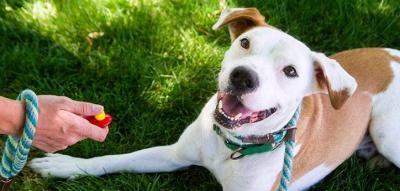
A Guide to Clicker Training Pets
Clicker training dogs, cats, and other animals is a fun and effective way to communicate with your pets. Besides dogs and cats, you can train almost any kind of pet — including birds, rabbits, rats, and horses — to respond to the clicker. For example, you can teach your dog to sit or your bird to hop onto a perch using clicker training. The only thing you need is a clicker, some treats, and an animal friend.
What is the clicker training method?
Clicker training is gentler than many traditional training methods. In clicker training, you mark good behaviors by clicking the clicker the instant they happen, and then reward the animal. The reward can be a food treat, pets, praise, or anything else the animal enjoys. If the animal doesn’t do the behavior you want, you simply try again and wait to mark it with the clicker. There is never any punishment for mistakes.
Clicker training uses a method called operant conditioning, pioneered by psychologist B.F. Skinner in the 1960s. Skinner observed that an animal will tend to repeat an action that has a positive consequence and will avoid an action that has a negative consequence. If a primary reinforcer (such as food) is used, the animal will become conditioned to repeat the action that produces the food. Using operant conditioning, Skinner trained rats to push a lever that released food pellets.
The clicker is used as a conditioned reinforcer, a cue that something good is coming. A form of clicker training (using whistles) was originally used with great success on dolphins. In the 1990s, clicker training for other animals really took off when trainers realized how easy and effective it was.
How does clicker training work?
Clicker training works by getting your pet to expect something enjoyable (like a treat) in return for doing something you ask. You use the clicker so that your pet will associate the treat with the clicking noise.
Here are some tips for how to clicker train your pet.
Home starts with you
Choose the best clicker. There are several types of clickers, and you will want one that elicits a noise that does not startle your pet. Cats, for example, are sometimes frightened by a loud click. Some pets may even require a very soft clicking sound, such as that made with a ballpoint pen.
Charge the clicker. Next, you’ll need to “charge” the clicker — that is, give the clicker a particular meaning so that your pet associates something good with it. Think of it like this: The first time you use an electric can opener to open a can of cat food, that sound means nothing to your cat. But after you’ve made that sound a few times, and a bowl of food promptly appears, your cat expects food when they hear the can opener. That’s the type of association you want your pet to have when they hear the clicker.
To start, make sure you have your clicker and some soft treats on hand, cut or broken up into small pieces. Next, position yourself near your pet, someplace quiet where there aren’t any distractions. Push and release the clicker, and then immediately give your pet a treat. Repeat this numerous times. You want your pet to expect a treat every time they hear the clicking noise.
Use the clicker to reward behavior. Next, when your pet does anything that you’d like them to repeat, you can “capture” that behavior by click-and-reward. You’re sending the message “What you just did is good,” and your pet will want to do that behavior again. It usually only takes a few repetitions for a pet to learn that a particular behavior elicits the click, followed by the reward.
For a behavior you would like your pet to do, you can do a click-and-reward when there’s even small movements in the right direction. For example, if you are working on teaching your dog the “come” cue and they take two steps in the right direction, click the clicker and offer a treat. After they learn that this small step elicits a reward, withhold the click until they move a bit closer to you. Repeat this exercise until your dog eventually comes all the way to you. This process is called “shaping.”
What if my pet doesn’t do what I ask?
First, don’t ever push, pull, or force your pet to do what you want. If your pet doesn’t do what you’ve asked (like sit or come), don’t click or offer a treat.
You can try to help them get the idea by holding the treat above their nose (to get them to sit) or by walking away from them and holding the treat out in front of you (to get them to come). This strategy is called “luring.”
What other things can I teach my pet?
Once your pet has learned one behavior via clicker training and does it every time, you can start adding others. Don’t try to teach more than one at a time. Here are some examples of other behaviors to click and give treats for: holding up one paw (high five!), sitting up on their hind legs, turning in a circle, or stepping up onto or down from different surfaces
Remember:
- Click while or immediately after the behavior happens.
- Always click first, and then offer a treat.
- Only click once.
Keep the practice sessions short. You want your pet to enjoy clicker training, so don’t make it into a chore. Have fun clicker training your pet.
